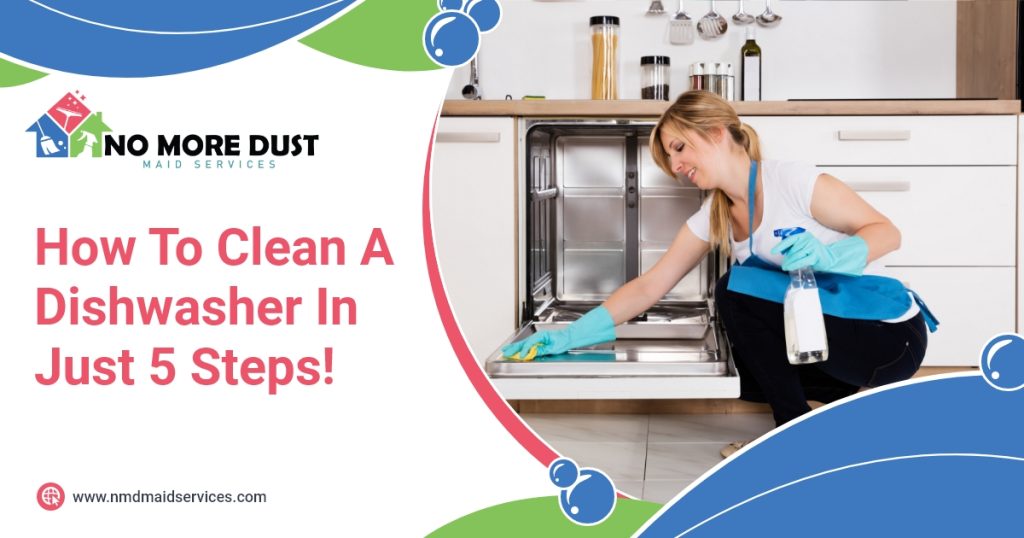Your dishwasher might help you day after day to wash off the remnants of your dinner, but that doesn’t mean it cleans itself every time it does your dishes! In fact, it accumulates its fair share of grime and dirt over time.
So, if you’re up to giving your dishwasher a well-deserved clean, you’re at the right place. The best part is you don’t need to spend your money on fancy products. Here, we’ll show you how you can leave your dishwasher spotless with items you already have in your pantry; check it out!
Step #1. Clear out your dishwasher
Before diving into the cleaning, make sure your dishwasher is completely empty. Take out the racks, utensil holders, dishes, and anything else you find inside.
Pop those racks and holders into the sink with some warm, soapy water while you clean your appliance. This way, they’ll be dry and ready when you’re done.
Step #2. Wash the filter
Cleaning the filter is one of the most important steps. Neglecting it could lead to all sorts of issues like blockages, leaks, or even a busted water pump. Plus, if you catch a funky smell coming from your machine, chances are it’s because the filter is clogged with food gunk.
Here’s the proper way to clean the filter:
- Remove the filter, typically a small circular gadget located at the bottom of the dishwasher. Twist and lift, or consult the appliance’s manual if you’re unsure.
- If your dishwasher has a mesh filter, pull that out too.
- Clear out any lingering food bits from where the filter sat.
- Pop both filters into the sink, hit them with warm, soapy water, and scrub away the grime. Use a soft toothbrush for the mesh filter and your kitchen sponge for the other one.
- Put the filters back where they belong, ensuring they’re in the right order.
Note: Some dishwashers boast self-cleaning filters, so if yours does, feel free to skip this step.
Step #3. Pretreat the dirt
To get better results, pretreat the walls of your dishwasher. This makes it easier to tackle stubborn food stains.
Grab a clean cloth, dip it in warm, soapy water, and wipe down all the goo and gunk. Not everything will come off, but the worst offenders should be softened up. You can also use a toothpick or clip to unclog water jet holes.
Note: Gunk on the door’s rubber seal can cause leaks. If you spot any, scrub it with soapy water and a soft toothbrush.
Step #4. Run a cycle with vinegar
Vinegar plays a crucial role here in dissolving hard water spots—those chalky white stains on the walls. Fill a dishwasher-safe bowl with two cups of vinegar, place it on the dishwasher’s floor, and let the machine run a hot water cycle.
Once done, the white spots should vanish, and grease will be easier to deal with. Plus, vinegar fights bad odors!
Note: Don’t worry about vinegar damaging your dishwasher—it’s safe! Just don’t pour it into the detergent compartment.
Step #5. Run another cycle but with baking soda
Once you’re done with the vinegar, run a short hot water cycle again, but this time, cover your dishwasher’s floor with a thin layer of baking soda. Baking soda will finish the job by dissolving any remaining stubborn stains, gunk, and grease in water.
Finally, run a drying cycle before putting the racks and holders back in.
Note: If your dishwasher doesn’t have a drying cycle, dry it manually with a clean microfiber cloth, paying attention to slits and tiny holes to prevent mold growth.
We can take over your cleaning chores easily!
Cleaning your dishwasher is just a chore in the checklist for a clean home. If you don’t have enough time for the rest, leave it to us! No More Dust Maid Services will send your home qualified maids so you can enjoy a cleaner place. Get a free quote today!




